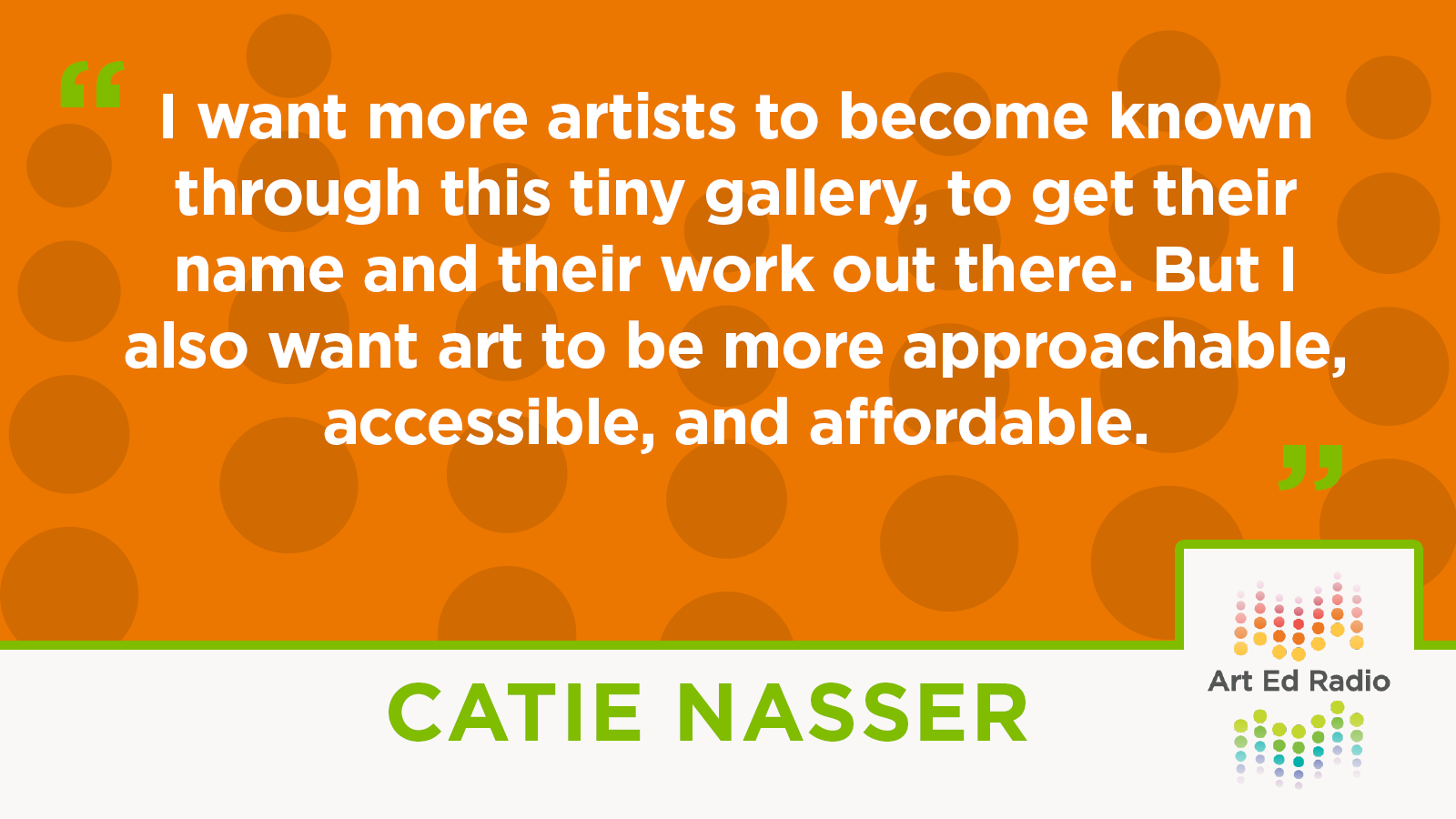Tiny galleries are a spectacular way to bring art to more people, making small galleries and small work available and accessible. But what does it take to create a tiny gallery? In today’s episode, Catie Nasser talks to Tim about her adventures with a tiny gallery, from the original idea to the building process to the upcoming opening, and everything in between. Full Episode Transcript Below.
Resources and Links
- Follow Catie on Instagram
- Also follow the Melrose Tiny Gallery
- Listen to the ‘Tiny Art Show’ podcast episode
- How Tiny Art Can Lead to Big Awareness

Transcript
Tim: Welcome to Art Ed Radio, the podcast for art teachers. This show is produced by the Art of Education University and I’m your host, Tim Bogatz.
A few weeks ago I had Janine Campbell on the show to talk about her experiences this year, her work with automatas, getting the COVID vaccine. Just a lot of different topics. And in the course of that conversation, we talked about Janine’s NAEA presentation with Catie Nasser. And I mentioned how I wanted to have Catie on the show because she does so many cool things and she is here today. And so we’re going to talk today about the tiny museum that she is creating in her community. It is such a cool idea, and she’s doing a lot of interesting things with it, and I think it’ll lead to a good discussion.
Now we’ve talked about tiny art shows before. It was about two years ago I think that we did an Art Ed Radio episode with McKay Lenker Bayer, the art teacher behind the first tiny art show. That was a fascinating conversation. And if you listen to that, it’ll give you the story and the inspiration behind the idea. And just last month Jonathan Juravich wrote an article for the AOU magazine about how he sets up tiny art shows in his school. Both of those are great resources, both the episode and the article, if this is a topic that interests you and something that you want to dive into a little bit further.
But Catie with her tiny art museum is doing something different. She’s building an entire… is a tiny museum making it more permanent, having gallery openings, and featuring different artists. So many really, really interesting things. I should honestly though, just let her tell you about it. So let me go ahead and bring her on.
All right. Catie Nasser is joining me now. Catie, how are you?
Catie: Hi, Tim! Thanks for having me.
Tim: Oh, thanks for coming on. We have a lot of exciting stuff to talk about. But welcome to the show first of all. And since you haven’t been here before, can you give us just a quick introduction, tell us a little bit about yourself, about where you teach, what your interests are?
Catie: Sure. So Tim said, my name’s Catie Nasser. I’m an elementary teacher. I teach K-6 elementary art, various combinations of those grades each year. I never quite know which ones they’re going to throw at me. And I also teach a class that I developed, I don’t know, maybe four years ago called artovation. And that’s a class that integrates innovation and art and robotics and steam and all kinds of crazy fun stuff into my art curriculum. So I kind of have two of those programs running at the same time. And that has provided me with tons of exciting new things to learn about, about ways to bringing innovation and learning in new ways into my art curriculum and showing kids that stuff too.
Tim: Yeah, that’s so cool. There’s a lot of really nice things going on there. Just knowing what I know from following you on social media and things like that, I’m always impressed with what you’re doing there. But I really wanted to talk about your new project, your big project, the tiny gallery that you’re doing. So can you just tell us about the tiny gallery that you’re creating?
Catie: Yes. So yes, I’m creating this tiny gallery. Last year, maybe last spring, the town I live in, in Melrose, Massachusetts put out a call for public arts and people could submit any proposal. And this was an idea that I had been wanting to do for a while. So I wrote up a grant proposal for this tiny gallery and it would be a public viewing place that would rotate just like you would see in a regular gallery that you might walk into, and this one you would just walk up to. And so I was selected as one of the grant recipients. They selected nine area artists, so nine artists through my community and people are doing all kinds of things. Murals, painting, electrical boxes. Somebody’s making a giant wooden sculpture of a dragon. So all kinds of different things in our city, it’s actually a small city. And so this was also selected, so I have been now tasked to create this tiny gallery. I’ve been kind of working on it since last summer I found out that I was awarded one of the grants.
Tim: Wow. That’s really cool. And it sounds like a lot of cool things going on, just all over the city. So that’ll be really, really nice. I’m curious though, about sort of where you got the idea for a tiny gallery. Where did the inspiration come from? Where did you get the idea for this project?
Catie: So, yeah, so like I said, I’ve had this idea for a while. I used to live in Somerville, Massachusetts, which has a really big thriving art community, almost a colony. There’s a lot of artists there. I think we have one of the biggest open studios, Somerville, in this country. So lots going on there. Years ago, I mean, I want to say 10 years ago was a tiny museum that opened up in Melrose. It was called the tiny museum, and it was installed right into a wall in an old, I don’t even know. It was like this think box or something really cool. It was right into the wall and it had rotating art and on tiny scale, and I thought that was so different and fun and whimsical. And I have ever since then have been wanting to create that myself. I’ve toyed around with building it and putting it in my yard or things like that, and so when this grant opportunity came up, I was, Oh, that’s what I want to do. So I finally have been given the chance to bring this to reality.
Tim: Nice. Now, just the way my mind works. I’m trying to picture this and trying to figure out exactly what it’s going to look like. And I have just a million logistical questions on how it all comes together. So can you tell us how the tiny gallery is built? How the artwork is made, how it’s all coming together to form this tiny gallery?
Catie: Okay. I will give you a picture. I mean think of the little free libraries that are popping up everywhere. So it’s along that same line where it’s going to be a small box that is installed on a post into the ground, so you will literally walk up to this gallery and see the arts. I’ve gone through various designs since… Like I said, I think in July or August I found out that I was getting this grant, and so I started designing and looked at little free library designs for their structure and also their size. I thought that was a great place to start, and then went from some of the more modern designs I saw from there into some other really modern designs, and then settled on this kind of classic Greek architecture-inspired design, because I want this to be around for years. I want this to be a longstanding thing. And I thought, well a classic, Greek looking little gallery will withstand time and still be relevant in 10 years or whatnot. And in Boston we have a lot of… Melrose is outside of Boston. We have a lot of that architecture anyway. Our MFA, our museum has pillars and has this Greek architecture look so I felt like it fit in with what people know as an art gallery.
So I designed this and in my plan was that I would be building this myself with a master woodworker that I know, my father-in-law who lives in Maine. And I shared my plans with him. He put them into his building software and developed kind of like a more three-dimensional model of it. And then, we’re in COVID times. So my plan to actually assist him in building it did not happen the way I wanted. So I’ve been in the role of the lead designer and making all the decisions and he’s helping me execute it, but he’s actually brought amazing ideas of things that I didn’t think about to this gallery.
He’s a woodworker by hobby, but he’s an engineer too. And he’s thinking about it as an actual structure, a building and he’s thinking, Oh, well, in the summer, it’s going to be way too hot. We have to do something to keep the art cool inside. So he thought, what if we did a metal copper roof that’s going to reflect the light and not absorb as much heat. And so he proposed that to me and we looked at some images. That looks great, so we did. If you look on my Instagram page for the gallery, you’ll see we have a metal roof now installed in the gallery.
So, he’s really been this process of I told him I want the floors to look like really nice polished floors. And I could go get a wood sample, but the scale is off. So there’s a lot of issues like that. Things that you could buy for it, the scale would be off because the dimensions are 12 inches by 25 inches, approximately. So he actually used, I want to say pine, but I’m not positive, but a blonde wood, so a light wood and cut it into these little thin planks and laid them down to look like floor for me. And then we’re going to put polyurethane on it. So it’s going to look like you’re in this really nice hardwood floor in a gallery. Just these little details that he just thinks about. Like, “What if I order a really thin floor molding?” Okay, that sounds great.
Tim: I can’t even imagine.
Catie: Obviously I wanted to help him do this, but it’s really been a gift that he agreed to do this with me because he is really thinking about things that I don’t think … I could have built the box myself, but it wouldn’t have been to the extent that he is helping me to do this. I think the museum in itself is going to be a work of art, let alone the art that’s actually going to be inside it.
Tim: Yeah. Well, okay. So I want to talk about the art in just a second, but you mentioned your Instagram page. Can give us the handle really quick if people want to-
Catie: So if you want to follow along with the gallery, it is @melrosetinygallery. So I post images there. Also, my own personal @catnasser. Both of those I’m posting updates and images. When we have called the call for art, which I think we’ll talk about in a minute, but when that comes up, all of that stuff will be posted on that site. So that’s where you would find out if you’re interested in having a show or an exhibition in our tiny gallery. That’s where you would find out all about that.
Tim: Okay. Super cool. And we’ll link those in the show notes also so whoever’s listening to that can check those out.
Okay. So let’s talk art, let’s talk shows, let’s talk artists who are going to be in there. Can you tell us your plan for how art is going to get into this amazing tiny gallery?
Catie: Yes. So, art is tiny. The gallery is tiny. The art is going to be tiny. So it will have a maximum size of three inches by three inches. And it doesn’t have to be square, but small. These are miniature works of art. I’m thinking also sculptural works. Could be small sculptural works. We have some pedestals in there. Again, like you would see. This will be a gallery, just miniature size. So, where we are with the art, so I think we’re hoping to have this installed the beginning of April. I think our ground is still frozen here, so we can’t quite get it in yet. And there’s some other logistical things to having it installed.
But we actually have our first art show lined up, which is going to be a children’s show. The gallery is located outside of a community arts center in Melrose called Follow Your Art. And they ran a camp in February on public art where the kids learned all about the different public artists that were involved in this grant and this initiative for our city. So as part of their week of camp, they created miniature works. I think there was nine students, nine kids in the camp that will have their artwork on display as the kickoff show. So, that’s really fun. I went in and talked to them about it, and we talked about the miniature scale and looked at so many works of art that I had and showed them my design, so I think that was fun for them.
And then as far as shows after that, I think it’s going to be a combination of group shows, solo shows. I really want to reach out to BIPOC artists in my community and the surrounding communities. I think that’s an important voice that needs to be heard and I would like to feature a show of their work.
I see this also as a way for, well, two things. One, an artist that’s maybe not as well known to get their name out there and get work out to the public to be able to see. But also, I mean, I would imagine that they would be wanting to sell their artwork and this is a way for people to collect art, to collect small pieces that are affordable because personally I love collecting art. When I go travel, I try to find a local artist and purchase art, but it’s expensive. So, but a tiny art piece, I think that that could be something that, more people could grasp being able to afford and maybe appreciate purchasing and starting their own art collection, personal art collection.
Tim: I hadn’t thought about that. That’s a really intriguing idea. I like that a lot, so that’s, I don’t know. Just anything that makes art more accessible, more approachable I think is worthwhile so that’s a really good idea.
And then one other question, just one art teacher to another. Do you see a role for your students getting involved with the tiny gallery or are you going to keep things separate? Will they have a chance to participate or is this something that you just want to make available to working artists in the community?
Catie: No, I definitely think I would like to have a child or a student presence as well. I teach in a different community than I live. I think I would love to see children in schools, from the community I live in maybe exhibited before the students in the community I teach in, but that doesn’t mean that I wouldn’t engage them in this process down the road. I would love to work with our local high school and Melrose, the seniors here, our Boston Globe gives out awards for artists, to emerging artists and Scholastic has their emerging artists program. I would love to feature some of those artists and have a partnership with the schools in Melrose. And then I could see, also including my own students in an art show as well, if I… I don’t see that out of the possibility.
Tim: Yeah. Very cool. I think there’s, yeah, a lot of really, really nice possibilities there. So, Catie, I think that covers everything that I was curious about and everything I want to know about the tiny gallery. So thank you so much for joining me, taking some time to tell us all about that. And yeah, we’ll get everybody following you on Instagram and kind of following along with the progress, especially as you get everything ready to go in the next month or so. So thank you so much, Catie. And hopefully we can talk to you again soon.
Catie: All right. Great. Thank you so much for having me.
Tim: All right. Thank you to Catie. I’m really wanting to have Catie and Janine, who I mentioned at the beginning present at the NOW conference this summer, so I hope we can make that a reality. And of course, I’m going to talk a lot about the conference between now and the end of July, so just fair warning for you. Just know that we have a lot of great things planned. We’re going to make the NOW conference a better experience than ever before, and it’s going to be worth your time. And if you visit the AOU website, you can sign up now at a discounted price.
But in the meantime, you can follow along with the tiny museum that Catie is creating and all of the tiny art that could be going into that museum. We’ll link to her Instagram page so you can follow the progress. And who knows it might inspire something in your students or in you as well.
Art Ed Radio is produced by the Art of Education University with audio engineering by Michael Crocker. We will be back next week with a celebration of AOU’s 10th anniversary, and some really fun behind-the-scenes stories from me and Amanda Heyn. We’ll talk to you then.
Magazine articles and podcasts are opinions of professional education contributors and do not necessarily represent the position of the Art of Education University (AOEU) or its academic offerings. Contributors use terms in the way they are most often talked about in the scope of their educational experiences.



